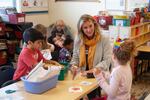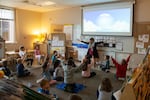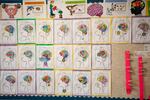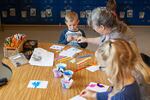When you step into Kate Tibbitts’ kindergarten classroom at Lava Ridge Elementary in Bend, it feels different.
Instead of bright colors and posters all over the walls, the tones are neutral and muted. The only materials hanging are intentional — a line of small pictures in a row pinned behind the reading table. Each picture has a different animal and advises kids to “ask for help” or “make connections.”
Almost every piece of paper is at eye-level for kids, designed to help them feel calm and focused — and ready to learn.
The classroom looks like this because of Kendra Coates. She’s the director of early education up to third grade at Oregon’s High Desert Education Service District, where she is part of a regionwide initiative to help teachers better teach social-emotional skills, such as self-awareness and relationship-building.

Kendra Coates sits with kindergarteners at Redmond Early Learning Center
Elizabeth Miller / OPB
For Coates, a key piece of that learning process is to remove stimuli that may overwhelm students.
“Part of understanding social-emotional development and behaviors is to understand how we can better design learning environments,” said Coates.
As educators look for a response to student behavior issues, Oregon guidelines emphasize teaching social-emotional tools, so that students feel comfortable learning, and that they develop skills such as self-awareness and relationship-building.
Growth Mindset: When Mistakes Mean Lemonade
Dr. Kendra Coates says she’s found a way to foster those social-emotional skills — she calls it “holding a growth mindset.”
“When we hold growth mindsets, we tend to look at challenges as the path to learning,” said Coates. “We tend to understand that mistakes are a part of the learning process.”
Coates helped design Tibbitts’ classroom. They met during Tibbitts’ first year teaching five years ago.
“I always felt like — even that first year — I was pushing the kids so hard, it’s almost exhausting,” said Tibbitts. “Trying to fill that whole day with academics and then feeling frustrated, like, 'What am I doing wrong?'”
Using Coates’ growth mindset foundation, Tibbitts says her students are now able to do more academically because they understand that learning is a process. The 5- and 6-year-olds also get a lot of “brain breaks” — five or 10 minutes during the day when they practice deep breathing or can dance around.

Kindergarteners in Kate Tibbitts' classroom take a "brain break," stretching before a lesson.
Elizabeth Miller / OPB
As Kendra Coates walks around Tibbitts’ room, she points out other visual elements of her education model. Books about brains and mistakes. Little couches and big pillows for flexible seating. And black-and-white outlines of kids’ heads covered in stickers.
The outline represents a brain, and the stickers represent neurons, says Coates.
“All these neurons … have been added over a period of time,” said Coates. “Students add them when they learn from a mistake, when they take on a challenge, when they problem solve, when they practice something, when they learn something new, when they work through a big emotion.”
Using a growth mindset looks and sounds different. Kids talk about how their brain is growing when they learn something new.
“It’s funny to hear kids when they’re 5 say hippocampus, prefrontal cortex, amygdala, neurons, connections,” said teacher Jill Anglin. Anglin’s kindergarten classroom is connected to Tibbitts’.

In classrooms Kendra Coates works in, the word "brain" and pictures of brains are everywhere.
Elizabeth Miller / OPB
In their classrooms, mistakes are made often and celebrated with lemonade. Kids have more control and autonomy to make decisions, especially during daily playtime — called "prefrontal cortex time," for the part of the brain that makes decisions.
It Started With A Yahoo Search
Coates is a statewide leader in helping teachers address students’ emotional needs. Her journey started more than 10 years ago.
Coates first came upon combining social-emotional learning and growth mindsets as a middle school teacher in a suburb of Portland. Teaching students with trauma, she realized she was reacting to students’ behavior — trying to help them after they’d had behavior problems at school.
“It was during that period of time that I started asking questions and trying better to understand what their early learning journeys were,” said Coates.
She started to wonder how her students got to be so traumatized and how they could’ve been better served in the classroom.
“I did a little Yahoo search — not Google, Yahoo search — and was trying to see preventing. I wanted prevention,” explained Coates.
Coates then built a curriculum around social-emotional learning — ways to teach kids self-awareness, decision-making and relationship-building.
If students learned these skills early, maybe they could self-regulate their behavior before ending up in a classroom like the one in which Coates taught at a middle school, where teachers reacted to students who'd been through traumatic experiences.
“What we’re trying to do is create a purposeful, intentional, preventative foundation to teach social-emotional skills,” said Coates.
From Rainbow Rug To All Gray Everything
For teachers, the move to using growth mindsets can be a real shift — starting with the physical classroom space.
Jill Anglin has been teaching for 27 years. Two years ago, she met Kendra Coates.
“We were talking about the environment and how it should be calming, and I started sweating,” recounted Anglin of an early meeting between Coates and other teachers.
As Anglin tells it, her room used to be bright and colorful with a rainbow rug for her kids to sit on. The rug also helped Anglin organize her students — she group students on different sections of the rug to dismiss them, for example.
Initially, Anglin refused to get rid of the rug. But a year into teaching growth mindset, the rainbow rug was out and a gray rug replaced it.
“It’s peaceful and relaxing,” said Anglin.
Music plays throughout Anglin's and teacher Kate Tibbitts’ rooms.
“Kindergarteners are loud and crazy in and of themselves,” said Tibbitts. “To have the balance of a peaceful space helps me feel more calm and helps me deal more calmly with situations that arise.”

During prefrontal cortex time in Jill Anglin's classroom, a few kids and a volunteer splatter paint on purpose after reading a book called "Beautiful Oops." “We tend to understand that mistakes are a part of the learning process,” says Kendra Coates, a teacher who helps educators better teach social-emotional skills.
Elizabeth Miller / OPB
In addition to themselves, Anglin and Tibbitts see differences in their students. They support each other as they learn together, work on academics during playtime and solve their own problems.
Anglin says it’s a better way of teaching for the kids.
“But sometimes it’s hard on my end because I don’t have the control over what everyone is exactly doing,” said Anglin.
What Happens After Kindergarten?
Implementing social-emotional learning tools can be a learning curve for parents too.
Desiree Margo is principal at Redmond Early Learning Center, a program that uses growth mindset schoolwide.
“We had a parent who said, 'You just need to be harder, and more black-and-white, and do these things, and then he’ll do what you want him to do,'” said Margo, summarizing a viewpoint that runs counter to the more exploratory approach of growth mindsets.
Margo says the school encourages parents to use social-emotional tools at home, but it takes time and trust.
The Redmond Early Learning Center ends at kindergarten, raising the question of what happens to kindergarteners when leave the growth-mindset setting for area elementary schools.
“We never want what we’re doing to drop off a cliff,” said Margo.

Kate Tibbitts reads with some of her students at Bend's Lava Ridge Elementary
Elizabeth Miller / OPB
In Redmond, Margo meets with elementary schools to talk about the support students need as they transition to first grade. And although she can’t keep tabs on every kindergartener, Margo is hopeful that students and teachers continue to use growth mindsets.
Even with the growing pains that come with a new curriculum, Margo looks forward to seeing children develop academically and emotionally.
“It’s how do we approach kids to where we open their hearts and, I would say, their minds to learning,” said Margo. “Not by squashing them. We’ve tried that — that’s compliance. But that’s not development.”
